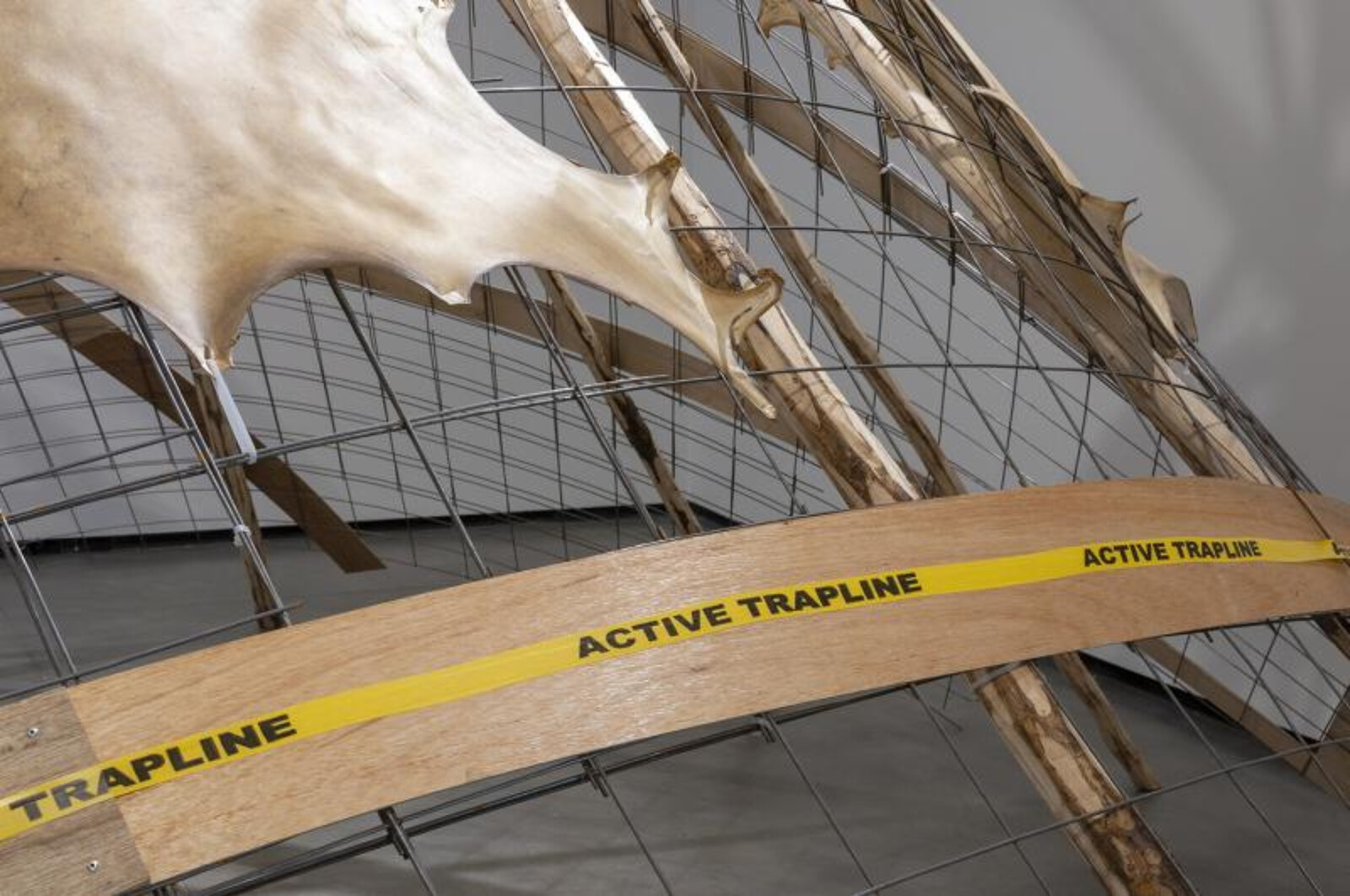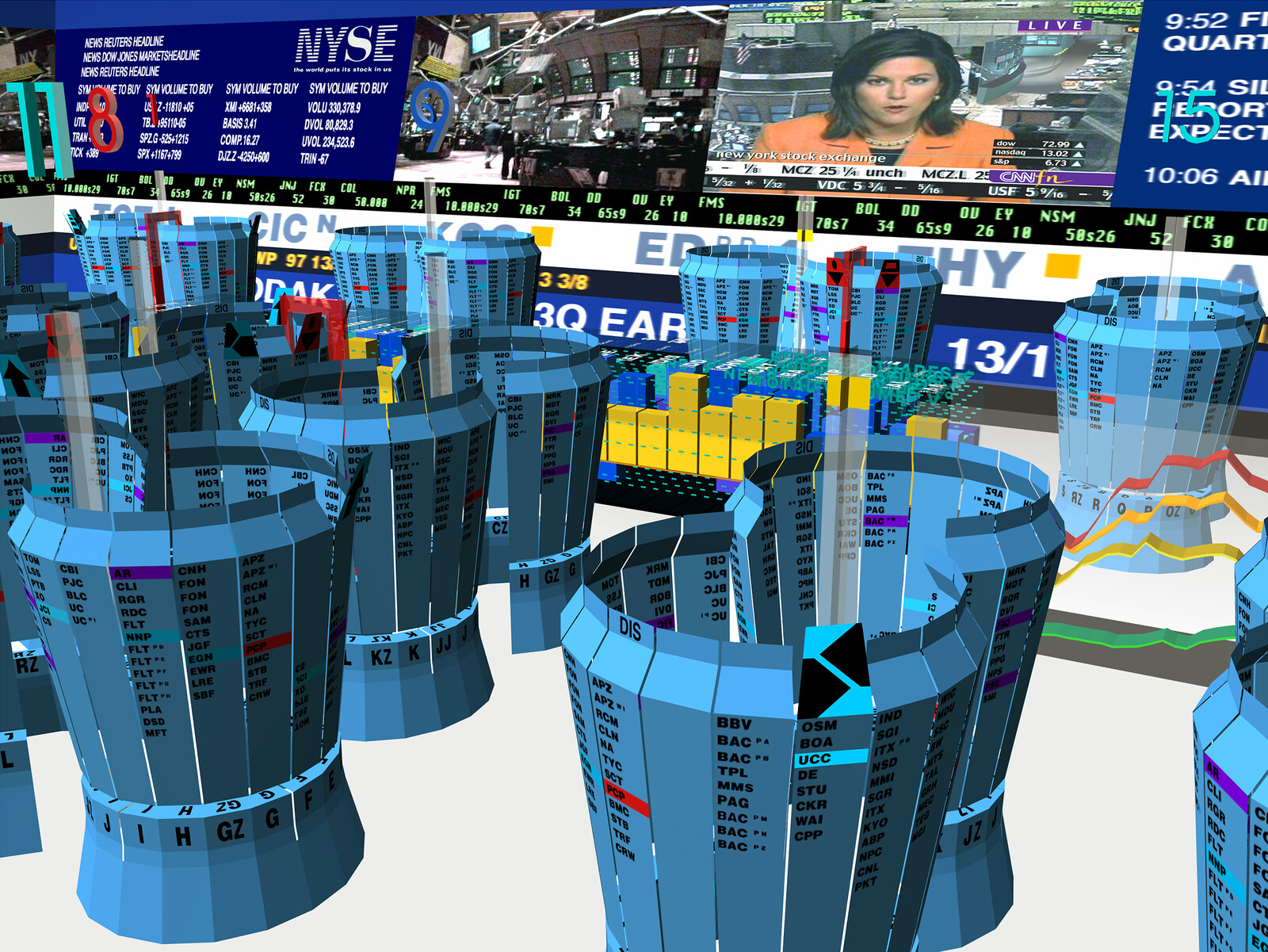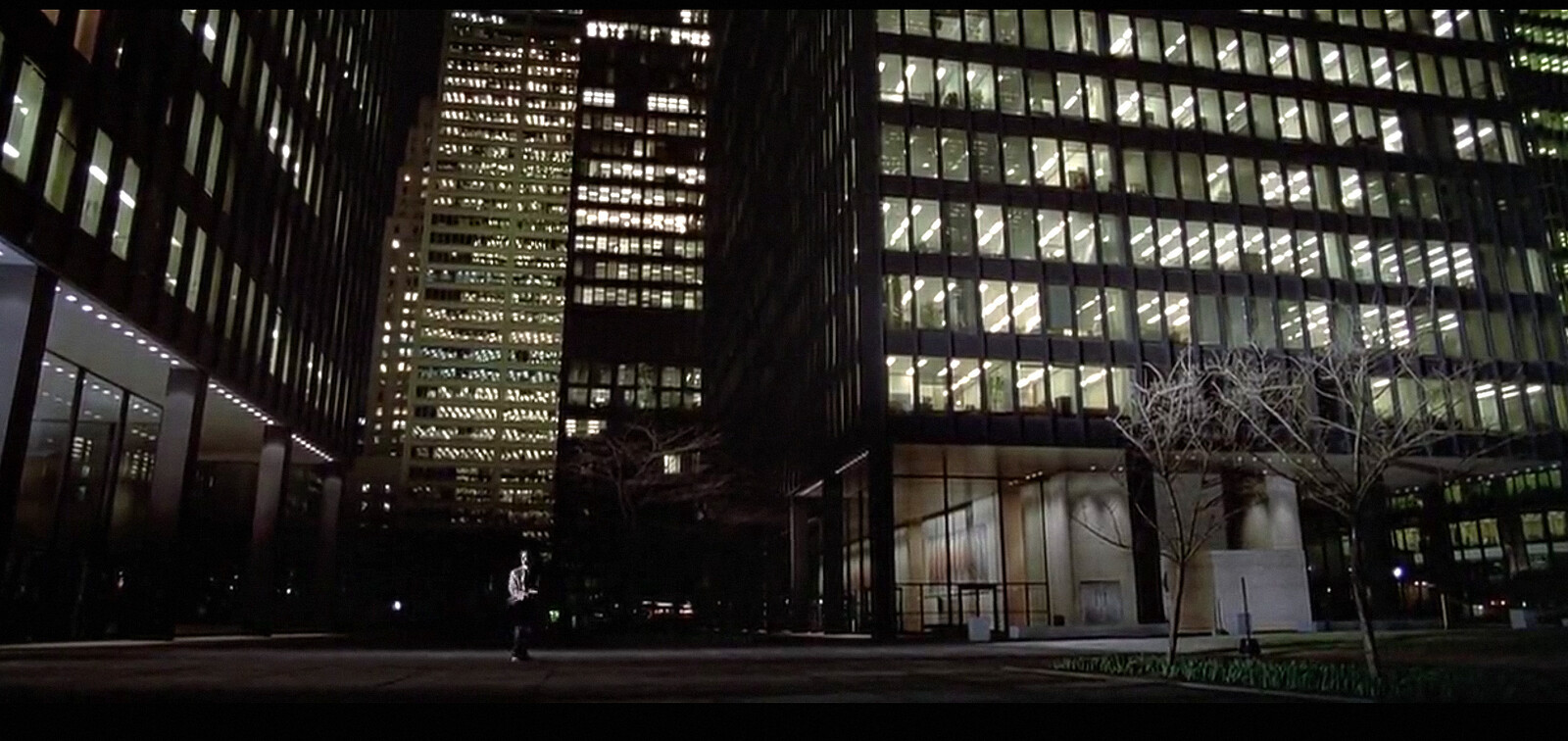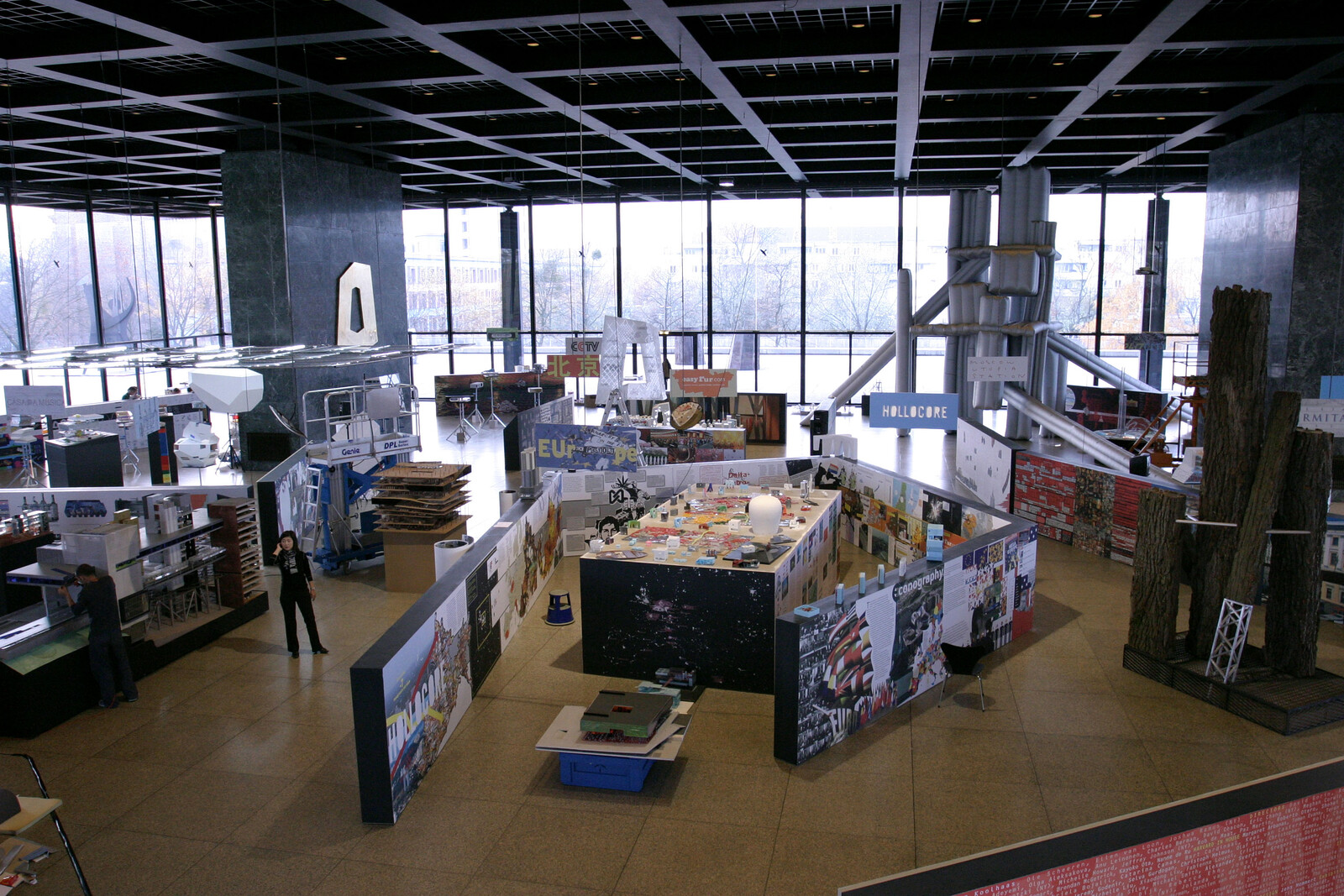No one is quite sure who the Trickster is, where it came from, what it is, or what purpose it serves, but it tends to unexpectedly show up in cultural narratives, often exposing human flaws and reminding us of our collective interactions, including exposing our unscrupulous behaviors. By no fault of its own, the Trickster is the shadow victim of the precarious light it carries in helping us to see things differently. Yet it’s also a psychological force, a rule maker and a rule breaker who thrives in the space of human conflict, exposing new distinctions, or as Susan White says, “keeping the world lively and giving cultures the flexibility to endure.”1
As an architectural visage, this Indigenous Trickster goes by the name LeCreebusier (LeCreeb, for short); an Indian Agent provocateur with a flair for design criticism. Gifted with situational awareness, LeCreeb is challenged with having to “make sense” of the human actions of a band of Cree people who occupy a swath of boreal forest across the northern shield. LeCreeb is not quite sure how the Swampy Cree, who live on both sides of James Bay, got their political clanship braids tied in a knot or how their active fur traplines got all tangled up, but one thing is certain: it was the Canadian government’s introduction of a series of imaginary provincial borders that divided the Cree from their homeland. From northern Quebec to northern Alberta, the Cree territory is vast. This context is key to understanding the situation.
A closer look reveals a layering of sorts by the “Other.” By this I mean that Settler societies have layered on top of Indigenous peoples’ stories of place, including Indigenous landmarks and the erasure of Indigenous place names. It’s the kind of presencing that Canadian architecture likes to describe as “found potential” in places that have always existed with a certain kind of being in the world. It’s unfortunate that this labeling of the Other was enshrined in Canadian politics by way of planning and design, as Indigenous people continue to be looked upon as the alternative, those situated in the margins, away from the center, less privileged, and hopefully, forgotten. Alas, the Trickster is there, but not. Due to their longstanding inferiority complex, Settler societies have yet to come to terms with their unscrupulous behavior. However, we are nonetheless witnessing an attempt to simply smooth things over by way of truth and economic reconciliation—as though Indigenous peoples didn’t pay and sacrifice enough! If (Indigenous) knowledge is power, then Settlers were and still are indebted to Indigenous societies for the former’s longstanding occupation and existence on Indigenous lands. But let’s save that conversation for another time, shall we?
Indicative of our current times, LeCreeb also has a flair for twenty-first-century technology. Rocking the Spotify digital waves, the last we heard it was squawking into an Indian reservation podcast: “We are programmed to receive. You can check out any time you like, but you can never leave!”
Shocked? I think not. The irony of these provocative lyrics, provided by iconic rock band The Eagles (a raven’s nemesis), is that they remind us of the Indian Act. In existence since 1876 and while not a law, the Act nevertheless prevented the movement of First Nations people off reserve. To some degree, it likewise continues to give the Canadian government license to control almost every aspect of Indigenous peoples’ lives and will forever cast a dark shadow on Canadian history. This is especially the case when the Act provided the state with justification to apprehend children to attend Indian residential schools and indoctrinate them with a sense of self that ran counterintuitive to the Indigenous worldview to which they had been accustomed and modeled. Herein, LeCreeb sees the significance of the idea to model—to bring into the world an idea, experience, or object of deliberation as one knows it. To make matters worse, Indigenous communities were prohibited from practicing any spiritual beliefs and customary practices that their ancestors with Indigenous knowledge had instilled in them. Accustomed. Customary. Custom. Habit. Practice. Rite. Spiritual!


Northern Ontario’s tiny Attawapiskat First Nation (substandard housing conditions). Source: Huffpost.
Modeling, Interpreting, and the Design Projection of Indigenous Knowledge-in-Action
It is an understatement to say that design-planning strategies are put to the test in the far reaches of Canada’s North—the immense hinterland of Canada that lies beyond the narrow strip of the country in which most Canadians live and work. This is where a majority of the 634 First Nations communities are geographically located, and where precarious access to safe drinking water is compounded by inadequate housing, underfunded infrastructure, limited access to social services, and flood security measures that have disrespected and violated Indigenous lands. It is where the rubber meets the road; the point at which things become truly or meaningfully challenging. It is for this reason that First Nations communities continue to be treated as a testing ground for design concepts and ideas developed by those living in the south, along the narrow 49th, and who more than likely have never stepped foot into a First Nations community. Often these well-intended aspirations are initiated at face (or “Zoom”) value under “quality controlled” market conditions or university research labs waiting to spin the First Nations roulette wheel.
“Hear ye! Hear ye! Place your Indian silver dollar down, wager a bet, half in, half out, along the line. Winner every time! That’s right folks! Winner every time! Except you, First Nations community, you’re a ward of the State,” which implies you’re the Queen’s House (of Common) hand and the Royal’s flush wins every time! Coming to you live from Casino Kanata,” squawks LeCreebusier.
Financial sleight-of-hand is the flip side of true reconciliation; the latest form of trickery offered up by the Canadian government. Economic reconciliation is a parachute model of federal funding geared for short-term gain which provides too little opportunity for Indigenous communities to deploy their long-term observance of site, seasonal awareness, local understanding, and knowledge of how place works (or doesn’t). Instead, Revit models based on parameters from the south conjure up renderings and design solutions with no actual understanding of how things function on the ground or in the hands of First Nations peoples. For many Indigenous northerners, there is a certain way of being in the world that is built upon intergenerational Indigenous knowledge. And that’s only a surface analysis based on what we see taking place “inside the community”—that is, the federally regulated reservation border. What occurs outside the community, out on the land, is where the real cultural action (and inaction) takes place.
I say “inaction” because there has been an influx of unnatural materials, foreign assemblages, and consumerism into Indigenous communities that has disparagingly contaminated, gamified, and altered our entire mudflat ecosystem. These discarded items never seem to recede, be reclaimed, or recycled through acts of Indigenous stewardship. In fact, many communities believe it’s far more valuable to extract and export natural resources than it is to reclaim and restore the landscape that seeded our Indigenous knowledge. What results is a further decentering of Indigenous living away from the natural and into an abysmal synthetic sea of compounds, components, and heterogeneous elements made elsewhere.
As we live a semi-nomadic life between seasonal hunting camps and inadequate housing often funded by the federal government, one must wonder how we can maintain our Indigenous sensibility when we are assailants in the environmental crises that lays before us. Whether by way of shotgun shells and their plastic casings, which will forever remain scattered across the muskeg, or discarded Jerry gas cans used as target practice devices, not only are we a detriment to the environment, but we also continue to use plastic-laden (oil-based) decoys in place of the handmade artifacts that preserve the tactile importance and wisdom of Indigenous knowledge.
Indeed, as Indigenous hunters grapple with the demands of standardization—using plastic luminant materials, camouflage tarps in place of (animal) skins, and SPF plywood in place of black spruce—Indigenous communities are under increasing pressure to alter their Indigeneity in the hope of keeping pace with an ever-changing world. But the situation is one in which Indigenous hunters have haphazardly painted themselves into the center of circle and can’t seem to get out. This is akin to the circular room being a knee-jerk reaction that most, if not all non-Indigenous architectural firms start with when designing on Indigenous land. Have we begun to culturally hinder and hunt ourselves into extinction? It’s no wonder that LeCreebusier is left standing on its head trying to make sense of the realities on the ground, all while those holding the Treaty 9 purse strings in Ottawapiskat continue to make uninformed policy decisions about the livelihood of northern Indigenous peoples.
And so, it is LeCreebusier that must put forward an architectural model of interpretation that projects Indigenous knowledge into the future, one whose design sensibility incorporates a bold sculptural and cultural expressionism, as well as an Indigenous axiology and “concepts of worth” such as the Land Back movement, which inspires the next generation of Indigenous youth to self-define the innate goodness or value of land-based learning.
ᐊᔭᒥᐦᐃᑐᐎᓐ | ayamihitowin | dialogue
From an Indigenous worldview, before one can model, one must listen, observe, and follow by sense of touch or feeling. This is not dissimilar to Paulo Freire’s notion of dialogue as the basic operation in the structure of knowledge: “Dialogue requires thoughtful action demonstrating not only the positive connection between people, as well as the constant drive to transform both ourselves and reality. Therefore, dialogue becomes the sign and central concept of true education: without dialogue there is no communication, and without communication, there can be no education.”2 From this perspective, according to Freire, the most important part of education is encouraging creativity. Knowledge isn’t born in a vacuum; it comes out of specific sets of conditions, meaning that it’s never neutral. This largely describes the Canadian First Nations’ condition: it is always in a state of flux, fluidity, and movement, shifting and reshaping through the forces of nature, from the rural to the urban to the world. Forever juxtaposing the ideas that homeland is neutral, and identity is stagnant, our identity sways and transforms depending on the context of our needs, reminding us that:
Our bodies and movements are in constant interaction with the environment; the world and the self inform and redefine each other constantly. The percept of the body and the image of the world turn into one single continuous existential experience; there is no body separate from its domicile in space, and there is no space unrelated to the unconscious image of the perceiving self.3
Juhani Pallasmaa’s domicile in space gives rise to an Indigenous ontology that runs parallel to Henri Lefebvre’s idea that constant interactions and actions produced by people (regardless of culture) lead to many creative expressions, including the use of Indigenous language, and form the “social” side of planning.4
In Omushkegowuk, the principal language of the Swampy Cree, we have a term to describe a sense of cultural ontology, “oshichikeywin,” which translates as “bending it from the body.” The Omushkegowuk homeland exhibits this bending quality with its low-level grassland and thin boreal tree line that is connected by a spidery network of rivers and mudflats that drain into the colonial named inland seas known as Hudson Bay and James Bay. It is a traditional territory that was haphazardly annexed by the 1872 Quebec-Ontario border. The annexation of this Indigenous landscape not only severed the Cree people within and across these territories, but it also fostered a host of uncertainties between Anglophone and Francophone communities. For this reason, context is key to understanding intentionality and all its political ramifications.
Akin to many Indigenous languages throughout the world, Omushkegowuk Cree ascribes to a verb-based etymology informed by land-based patterns, observations, seasonal practices, and bodily actions that inform and uphold our (m)oral understanding of place. The body not only speaks; it also listens, tacitly, in a way that is salient and silent, more personal and less interrupted by the laissez-faire attitudes of strained Settler-Indigenous relations. In this way, silence brings forward a genuine sense of Indigenous design knowledge to be projected into the future—wherever that may be—and it is equipped with the ability to stop, pivot, and carry on through, thus exhibiting “a shift in mind that drops down to feeling.”5
This acute sensibility to the muskeg (a term of Cree origin; maskek meaning low-lying marsh), a Cree indigenous landscape, can be abstracted as an Indigenous way of knowing, doing, and making—”kiskeyitamowin,” “oshichikeywin,” and “itotamwin,” respectively—which lends itself to a phronetic way of modeling. It is poiesis, to be exact, or reflective thinking that makes use of cognitive cultural skills to reflect-in-action. As part of a personalized Indigenous paradigm, poiesis allows the Indigenous designer (alongside community) to self-measure against historical and contemporary forces by revealing the nature of culturally specific patterns, values, and living expressions, refining place-based practices by bringing them into direct and instant contextual involvement. Poiesis also allows for one’s culture to act as a modifying factor, posing a deeper range of questions about the way we ought to go about planning and designing for Indigenous communities. Critically, this requires Indigenous designers to reclaim the necessary space where they are best able to synthesize multi-cultural perspectives or observations with the realm of real-world experience.
By expressing one’s (personal) praxis, (interpersonal) ethos, and (trans-personal) poiesis, modeling, interpretation, and design can provide a renewed sense of purpose and fortitude to co-opt—and possibly even create new—Indigenous knowledge and/or approaches to Indigenous design.
Modeling abstracts some aspect of reality and incorporates select empirical data into the abstraction—ideally, what we know from seeing, hearing, touching, smelling and observing. Modelling (or prototyping) as a methodology aims towards the authentic (in relation to a specific phenomenon), which in turn requires a trade-off between empirical data and theoretical validity. It involves techne and the making of typologies, abstracting one aspect of reality while bringing something else into being that was not.
Interpretation involves iteration, moving backward and forward between theoretical propositions and/or understandings, including categories of empirical observations, and tends to inform all aspects of design representation and planning related activities. Interpretation can range from investigating people and their relationships to place (or artifacts) and is widely used in the disciplines of ethnography and discourse analysis. As a methodology, interpretation insists that facts do not speak for themselves, but always through a (culturally encoded) interpreter, knowledge keeper, or archetype.
Design evaluates new possibilities by applying systematic processes and procedures to new datasets in relation to design experiments. While the context is determined, the artifact (object or model) is a mixed variable with design parameters. Design projection is a reflexive strategy and relies upon individual creativity, imagination, and insight, and is therefore subjective.6
Wakinakan
Memory of place and one’s upbringing around knowledge keepers (or Elders) is the bases of our worldview, ontologies, and the way we see things through their eyes.7 Robin Wall Kimmerer reminded me of the ways of my grandparents and the communal relations they had with place. Humble in their approach to making community, they, like many other Cree people, had to endure and create something out of nothing across a wispy black spruce landscape that, for the most part, was unforgiving during the winter months but giving in times of spring renewal. In a place that comes to standstill during the frigid winter, where harvesting takes a back seat to the forces of nature and one must wait until the Moose River tide comes in before one can move, I’ve often asked: “What kind of activity filled the hours, days, and weeks before the next seasonal change arrived?” This is more a question of contemplation than it is of consummation, and in that I consider the role “wakinakan” had to play in modeling a Cree lifestyle. Wakinakan is the Cree word used to describe tamarack, a bendy hardwood that not only carried us across the frozen muskeg landscape in the form of snowshoes, but also provided us with the highest degree of warmth as a fuel source. The denser the wood, the hotter the flame. But as an artisan, it is the subtilty of the material that teaches us about observance of place, when and how to prepare, how to model, and, more importantly, how to “expand our senses” (“kiwepakitinikewin”) to what the Indigenous landscape has to offer.8 The Cree term kiwepakitinikewin describes “the act of sharing something and become larger in the process.” It expands the person in its exercise.
Given the enduring challenge to survive and live in one of Canada’s more extreme environments, wakinakan also provided us with an economic material practice that coincides with the idea of situational awareness. The knowing, doing, and making process for niska (geese) decoys offered the “return to first principles” that I was seeking during my educational and professional training to become an architect. It’s a design exercise that spans all four seasons, bridging fall and spring harvesting practices. As one starts to see, wakinakan models a Cree worldview and an Indigenous epistemology. The process of modeling Indigenous knowledge and its architectural interpretation and design projection runs parallel to Kenneth Frampton’s “critical regionalism,” the fundamental strategy of which is to mediate the impact of universal civilization with elements derived indirectly from the peculiarities of a particular place. In this way, practicing kiwepakitinikewin puts us directly “in touch” with our normative visual experience by readdressing the tactile range of human perception. And as Frampton further states,
[The tactile’s] capacity to arouse the impulse to touch returns the architect to the poetics of construction and to the erection of works in which the tectonic value of each component depends upon the density of its objecthood. The tactile and the tectonic jointly have the capacity to transcend the mere appearance of the technical in much the same way as the place-form has the potential to withstand the relentless onslaught of global modernization.9
The notion of a contemporary Indigenous “resistance structure” informed by the resurgence and reclamation of Indigenous identity seeks to mediate the impact of global civilization, wherein it must also be willing to come to terms with the proliferation of twenty-first century materials that are now scattered across the Indigenous landscape. An extractive resource industry has provided temporary comforts in the form of standardized building products and a plethora of discarded plastic emotions. Plastic is informed by the quality of disbarment (by the wayside, discarded, packaged, and shipped throughout the world). It therefore carries no intrinsic value to Indigenous cultures, whereas wakinakan, albeit ephemeral, has cultural value because it is an essential ingredient to placemaking and is a direct extension of Cree epistemology, ontology, and axiology. Its wispiness represents our bending ways, bodies, and the minute connective tissue that holds things together.
Taken together, oshichikeywin, wakinakan, and kiwepakitinikewin are the prime aspects through which we shape and navigate the boreal landscape around us. This marriage of language and landscape is the foundation of our material wisdom. It informs our cultural ethos, our shared identity, and during the long winters for our Elders, it was a contemplative way of figuring, working, and carrying things out in accordance with the natural laws of place. With conversations about a circular economy ascending the political agenda, we must acknowledge that circularity has been a way of life for millennia for Indigenous peoples worldwide, as exemplified in wakinakan.10 The key for Indigenous people is not to get caught up in the circular trappings that are often ill-defined by Settler (non-Indigenous) designers seeking a foothold in the First Nations architectural design market. Rather, this is the latest strategy to validate Settler societies’ understanding of place despite, quite frankly, having no intimate or temporal knowledge of Indigenous landscapes.
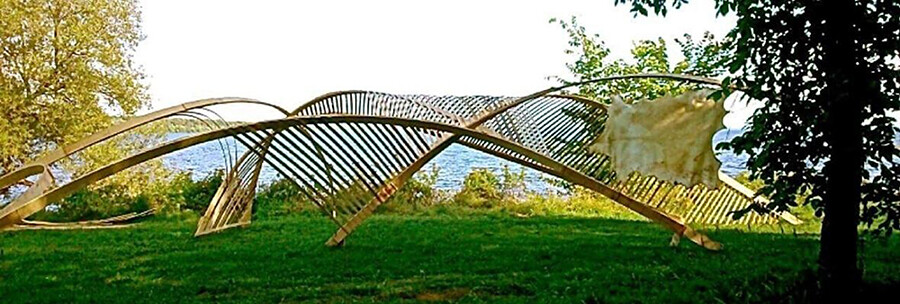

Weypiskosiweywin I (The People Have Moved Camp), 2014.
Visage
How do I begin to model a piece of work that has to consider scale and material behavior, along with the development of connections, while still being able to fashion an Indigenous worldview? The project Weypiskosiweywin I (The People Have Moved Camp) (2014) fostered an alternative approach to architecture modeling informed by cultural knowledge, which required discipline to observe and stay grounded in an Indigenous worldview. I have come to understand that, in contrast to sketching, it is far more valuable to learn the structural capabilities and performance values of a material before beginning to draw. By bending a material under human force—by applying my entire body, ethos, and Indigenous knowledge-in-action, I allow for the tensile and compressive forces within the material to inform my experiential, model-making, and learning processes. As a result, my praxis is more richly informed and resilient to the cross-cultural forces that have shaped and sustained my Indigenous identity. In the journey of my praxis, I have understood this deliberative and reflective space of making as my “wapimisow,” or a more controlled awareness of my cultural identity, what this means as an Indigenous body politic, and how its design can be projected onto the world.
As we know, Indigenous design is fraught with strained relationships to place, especially as there is a host of power imbalances when it comes to the performance of Indigenous knowledge. For this reason, I employed here a sense of political behavior (coyness) through an Indigenous Trickster with an architectural visage, LeCreebusier. As Erich Jantsch states:
In the drama of existence, we are, as Niels Bohr put it, ourselves both actors and spectators. Pretending to be only spectators, we have built a body of rational knowledge. But we live in a mythological world of relationships in which we are also actors. And in an evolutionary perspective, the duality of our role dissolves completely—we are agents of an evolution which acts within and through us. Design makes use of all three levels or perception or inquiry. It may be viewed as an ensemble of iterative processes between consciousness, a malleable ‘appreciated world’ in our mind and reality—and in three human spaces: physical (embodied), social (community) and spiritual (cultural) spaces.11
The Trickster, LeCreebusier, is both an actor and a spectator in this narration and the production of the modeled work fashioned herein. But more importantly, its omnipresence is here to facilitate just as much as it disrupts and fascinates.
Adjusting the frequency, LeCreeb hears an “unceded voice from the land” come through. “Is anybody out there?” A voice of adolescence emerges—it is Chakabush, another Cree Trickster. “I’ve got a little black book with my sketches in. Got a St. Anne’s bag, got a toothbrush and a comb. When I’m a good boy the augurs sometimes throw me a bone. I got elastic bands keeping my moccasins on. Got swollen hand blues. I’ve got thirteen channels of shit on my Smart TV to choose from. I’ve got electric lights. And I’ve got second sight. I’ve got amazing powers of observation.” Imagination. Transformation. Reclamation. It’s time for Indigenous Resurgence.
S.J. White, “Unsettling Reflections: The Reflexive Practitioner as ‘Trickster’ in Inter-Professional Work,” in Critical Reflection in Health and Social Care, ed. J. Fook and F. Gardner (Maidenhead: Open University Press, 2006).
Paulo Freire, Pedagogy of the Oppressed (New York: Continuum, 1968).
Juhani Pallasmaa, Eyes of the Skin: Architecture and the Senses (Chichester: Wiley Academy, 2005).
Henri Lefebvre, The Production of Space (Hoboken: Wiley-Blackwell, 1992).
Leonie Sandercock, “Voices from the Borderlands: Meditations on a Metaphor,” in Journal of Planning Education & Research 14, no.2 (January 1995): 77-88.
K. Jake Chakasim, “Towards an Indigenous Planning Praxis: Resilience Personified” (unpublished manuscript, 2018).
Robin Wall Kimmerer, Braiding Sweetgrass: Indigenous Wisdom, Scientific Knowledge, and the Teachings of Plants (Minneapolis: Milkweed Editions, 2013).
The Cree term kiwepakitinikewin describes “the act of share something and become larger in the process.” It expands the person in its exercise.
Kenneth Frampton, “Towards a Critical Regionalism: Six Points for an Architecture of Resistance,” in Hal Foster, Anti-Aesthetic: Essays on Postmodern Culture (Seattle: Bay Press, 1983).
Alana Craigen, “For a Truly Circular Economy, We Need to Listen to Indigenous Voices,” United Nations Development Programme, November 11, 2021, ➝.
Erich Jantsch, Design for Evolution: Self-Organization and Planning in the Life of Human Systems (New York: George Braziller, 1975).
On Models is a collaboration between e-flux Architecture and The Museum of Contemporary Art Toronto.
